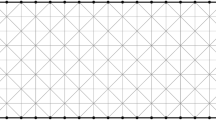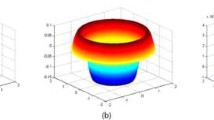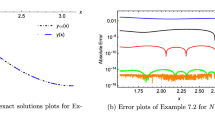Abstract
This article describes a numerical method based on the dual reciprocity boundary element method (DRBEM) for solving some well-known nonlinear parabolic partial differential equations (PDEs). The equations include the classic and generalized Fisher’s equations, Allen–Cahn equation, Newell–Whithead equation, FitzHugh–Nagumo equation, and generalized FitzHugh–Nagumo equation with time-dependent coefficients. The concept of the dual reciprocity is used to convert the domain integral to the boundary that leads to an integration-free method. We employ the time stepping scheme to approximate the time derivative, and the linear radial basis functions (RBFs) are used as approximate functions in the presented method. The nonlinear terms are treated iteratively within each time step. The developed formulation is verified in some numerical test examples. The results of numerical experiments are compared with analytical solution to confirm the accuracy and efficiency of the presented scheme.





Similar content being viewed by others
Data availability
The data used in this research article is not applicable as no specific data sets were utilized. The conclusions and findings presented in this paper are based on theoretical analysis, literature review, and other relevant scholarly resources. All references cited are available in the reference section for further examination.
References
S. Abbasbandy, Soliton solutions for the Fitzhugh-Nagumo equation with the homotopy analysis method, Applied Mathematical Modelling 32(12) (2008) 2706-2714.
K. Al–Khaled, Numerical study of Fisher’s reaction–diffusion equation by the sinc collocation method, Journal of Computational and Applied Mathematics 137 (2001) 245–255.
S. M. Allen, J. W. Cahn, A microscopic theory for antiphase boundary motion and its application to antiphase domain coarsening, Acta Metall. 27 (1979) 1085–1095.
W. T. Ang, A Beginners Course in Boundary Element Methods, Universal Publishers, Boca Raton, USA, 2007.
P. Alipour, The BEM and DRBEM schemes for the numerical solution of the two-dimensional time-fractional diffusion-wave equations, Authorea, Inc 2023.
G. Cao, B. Yu,L. Chen, W. Yao, Isogeometric dual reciprocity BEM for solving non-Fourier transient heat transfer problems in FGMs with uncertainty analysis, International Journal of Heat and Mass Transfer, 203, (2023) 123783.
B. Yu, G. Cao, S. Ren, Y. Gong, C. Dong, An isogeometric boundary element method for transient heat transfer problems in inhomogeneous materials and the non-iterative inversion of loads, Applied Thermal Engineering 212, (2022) 118600.
B. Yu, C. Geyong, G. Yanpeng, S. Ren, C. Dong. IG-DRBEM of three-dimensional transient heat conduction problems, Engineering Analysis with Boundary Elements, 128 (2021) 298-309.
B. Yu, G. Cao, Z. Meng, Y. Gong, C. Dong. Three–dimensional transient heat conduction problems in FGMs via IG–DRBEM, Computer Methods in Applied Mechanics and Engineering, 384 (2021) 113958.
B. Yu, G. Cao, W. Huo, H. Zhou, E. Atroshchenko. Isogeometric dual reciprocity boundary element method for solving transient heat conduction problems with heat sources, Journal of Computational and Applied Mathematics, 385 (2021) 113197.
B. Yu, H.L. Zhou, H.L. Chen, Y. Tong. Precise time-domain expanding dual reciprocity boundary element method for solving transient heat conduction problems, International Journal of Heat and Mass Transfer, 91 (2015) 110-118.
D. G. Aronson, H. F. Weinberger, Multidimensional nonlinear diffusion arising in population genetics, Adv. Math. 30 (1978) 33-76.
A. H. Bhrawy, A Jacobi-Gauss-Lobatto collocation method for solving generalized Fitzhugh–Nagumo equation with time–dependent coefficients, Applied Mathematics and Computation 222 (2013) 255–264.
C. Bozkaya, Boundary element method solution of initial and boundary value problems in fluid dynamics and magnetohydrodynamics, Ph.D Thesis, Technical University of Midell East, 2008.
C. A. Brebbia, D. Nardini, Dynamic analysis in solid mechanics by an alternative boundary element procedure, International Journal of Soil Dynamics and Earthquake Engineering 2 (1983), 228-233.
C. A. Brebbia, P. W. Partridge, L. C. Wrobel, The dual reciprocity boundary elements method, Computational Mechanics Publications: Southampton and Elsevier Applied Science: New York, 1992.
J.-W. Choi, H. G. Lee, D. Jeong, J. Kim, An unconditionally gradient stable numerical method for solving the Allen–Cahn equation, Physica A 388 (2009) 1791–1803.
M. Dehghan, F. Fakhar–Izadi, Pseudospectral methods for Nagumo equation, International Journal for Numerical Methods in Biomedical Engineering 27 (2011) 553–561.
M. Dehghan, A. Ghesmati, Solution of the second–order one–dimensional hyperbolic telegraph equation by using the dual reciprocity boundary integral equation (DRBIE) method, Engineering Analysis with Boundary Elements 34 (2010) 51–59.
M. Dehghan, A. Ghesmati, Application of the dual reciprocity boundary integral equation technique to solve the nonlinear Klein–Gordon equation, Computer Physics Communications 181 (2010) 1410–1418
M. Dehghan, D. Mirzaei, The boundary integral equation approach for numerical solution of the one–dimensional Sine–Gordon equation, Numerical Methods for Partial Differential Equations, 24 (2008) 1405–1415.
M. Dehghan, D. Mirzaei, A numerical method based on the boundary integral equation and dual reciprocity methods for one–dimensional Cahn–Hilliard equation, Engineering analysis with boundary elements 33 (2009) 522–528.
M. Dehghan, A. Shokri, Numerical solution of the nonlinear Klein–Gordon equation using radial basis functions, Journal of Computational and Applied Mathematics 230 (2009) 400–410.
M. Dehghan, M. Shirzadi, A meshless method based on the dual reciprocity method for one-dimensional stochastic partial differential equations, Numerical Methods for Partial Differential Equations 32 (2016) 292–306.
M. Dehghan, M. Shirzadi, The modified dual reciprocity boundary elements method and its application for solving stochastic partial differential equations, Engineering Analysis with Boundary Elements 58 (2015) 99–111.
X. Feng, A. Prohl, Numerical analysis of the Allen–Cahn equation and approximation for mean curvature flows, Numerische Mathematik 94 (2003) 33–65.
R. Fitzhugh, Impulse and physiological states in models of nerve membrane, Biophysics J 1 (1961) 445–466.
G. Hariharan, K. Kannan, Haar wavelet method for solving Cahn–Allen equation, Applied Mathematical Sciences, 3 (2009) 2523–2533.
G. Hariharan, K. Kannan, Haar wavelet method for solving FitzHugh–Nagumo equation, vol. 67, World Academy of Science, Engineering and Technology, 2010.
I. Dag, A. Sahin, A. Korkmaz, Numerical investigation of the solution of Fisher’s equation via the B-spline Galerkin method, Numerical Methods for Partial Differential Equations, 26 (2010) 1483–1503.
S. R. Karur, P. A. Ramachandran, Radial basis function approximation in dual reciprocity method, Mathematical and Computer Modelling 20 (1994) 59–70.
J. Katsikadelis, Boundary Element Methods, Theory and Application, Elsevier, 2002.
T. Kawahara, M. Tanaka, Interaction of travelling fronts: an exact solution of a nonlinear diffusion equation, Physics Letters A 97 (1983) 311–314.
P. K. Kythe, Fundamental Solution for Differential Operators and Application, Birkhauser, Boston, 1996.
H. Li, Y. Guo, New exact solutions to the Fitzhugh–Nagumo equation, Applied Mathematics and Computation 180 (2006) 524–528.
Y. Li, H. G. Lee, D. Jeong, J. Kim, An unconditionally stable hybrid numerical method for solving the Allen–Cahn equation, Computers & Mathematics with Applications 60 (2010) 1591–1606.
T. Mavoungou, Y. Cherruault, Numerical study of Fisher’s equation by Adomian’s method, Mathematical and computer modelling 19 (1994) 89–95.
R. E. Mickens, A best finite–difference scheme for the Fisher equation, Numerical Methods for Partial Differential Equations 10 (1994) 581-585.
R. C. Mittal, S. Kumar, Numerical study of Fisher’s equation by wavelet Galerkin method, International Journal of Computer Mathematics 83 (2006) 287–298.
R. C. Mittal, G. Arora, Efficient numerical solution of Fisher’s equation by using B–spline method, International Journal of Computer Mathematics 87 (2010) 3039–3051.
M. C. Nucci, P.A. Clarkson, The nonclassical method is more general than the direct method for symmetry reductions: an example of the Fitzhugh–Nagumo equation, Physics Letters A 164 (1992) 49–56.
J. S. Nagumo, S. Arimoto, S. Yoshizawa, An active pulse transmission line simulating nerve axon, Proceedings of the IRE 50 (1962) 2061–2071.
D. Olmos, B. D. Shizgal, A pseudospectral method of solution of Fisher’s equation, Journal of Computational and Applied Mathematics 193 (2006) 219–242.
C. Pozrikidis, A Practical Guide to Boundary Element Methods with the Software Library Bemlib, Chapman and Hall/CRC, 2002.
Y. Qiu, D. M. Sloan, Numerical solution of Fisher’s equation using a moving mesh method, Journal of Computational Physics 146 (1998) 726–746.
J. Roessler, H. Hussner, Numerical solution of the 1+2dimensional Fisher’s equation by finite element and the Galerkin method, Mathematical and Computer Modelling 25 (1997) 57–67.
M. Shih, E. Momoniat, F. M. Mahomed, Approximate conditional symmetries and approximate solutions of the perturbed Fitzhugh–Nagumo equation, Journal of mathematical physics 46 (2005) 023503.
A. Shirzadi, V. Sladek, J. Sladek, A local integral equation formulation to solve coupled nonlinear reaction–diffusion equations by using moving least square approximation, Engineering Analysis with Boundary Elements 37 (2013) 8–14.
A. Shiva, H. Adibi, A numerical solution for advection–diffusion equation using dual reciprocity method, Numerical Methods for Partial Differential Equations, 29 (2013) 843–856.
A. Shokri, M. Dehghan, A Not–a–Knot meshless method using radial basis functions and predictor–corrector scheme to the numerical solution of improved Boussinesq equation, Computer Physics Communications 181 (2010) 1990–2000.
S. Tang, R. O. Weber, Numerical study of Fisher’s equation by a Petrov–Galerkin finite element method, The ANZIAM Journal 33 (1991) 27–38.
H. Triki, A.–M. Wazwaz, On soliton solutions for the Fitzhugh–Nagumo equation with time–dependent coefficients, Applied Mathematical Modelling 37 (2013) 3821–3828.
R. A. Van Gorder, Gaussian waves in the Fitzhugh–Nagumo equation demonstrate one role of the auxiliar function \(H(x,t)\) in the homotopy analysis method, Communications in Nonlinear Science and Numerical Simulation 17 (2012) 1233–1240.
R. A. Van Gorder, K. Vajravelu, A variational formulation of the Nagumo reaction–diffusion equation and the Nagumo telegraph equation, Nonlinear Analysis: Real World Applications, 11 (2010) 2957–2962.
X. Y. Wang, Exact and explicit solitary wave solutions for the generalized Fisher equation, Physics letters A 131 (1988) 277–279.
A. M. Wazwaz, A. Gorguis, An analytic study of Fisher’s equation by using Adomian decomposition method, Applied Mathematics and Computation 154 (2004) 609–620.
A. M. Wazwaz, The tanh–coth method for solitons and kink solutions for nonlinear parabolic equations, Applied Mathematics and Computation 188 (2007) 1467–1475.
Author information
Authors and Affiliations
Corresponding author
Ethics declarations
Conflict of interest
The author declares no competing interests.
Additional information
Publisher’s Note
Springer Nature remains neutral with regard to jurisdictional claims in published maps and institutional affiliations.
Rights and permissions
Springer Nature or its licensor (e.g. a society or other partner) holds exclusive rights to this article under a publishing agreement with the author(s) or other rightsholder(s); author self-archiving of the accepted manuscript version of this article is solely governed by the terms of such publishing agreement and applicable law.
About this article
Cite this article
Alipour, P. THE DUAL RECIPROCITY BOUNDARY ELEMENT METHOD FOR ONE-DIMENSIONAL NONLINEAR PARABOLIC PARTIAL DIFFERENTIAL EQUATIONS. J Math Sci 280, 131–145 (2024). https://doi.org/10.1007/s10958-023-06642-4
Accepted:
Published:
Issue Date:
DOI: https://doi.org/10.1007/s10958-023-06642-4




